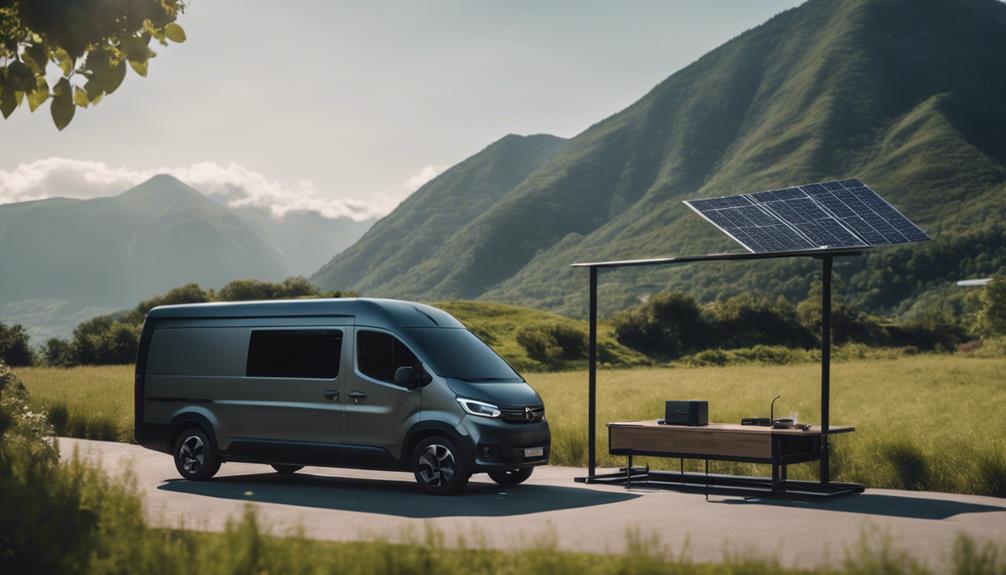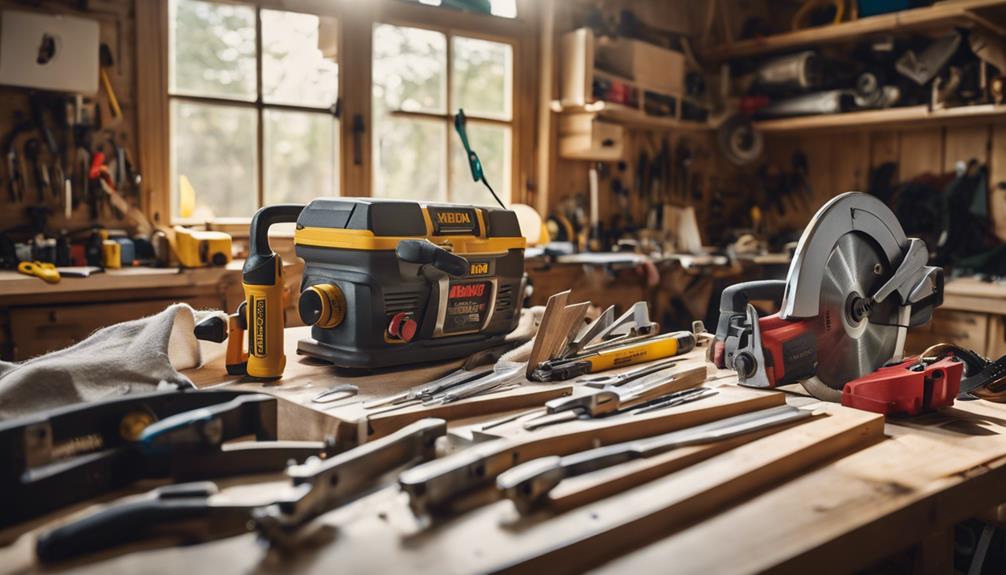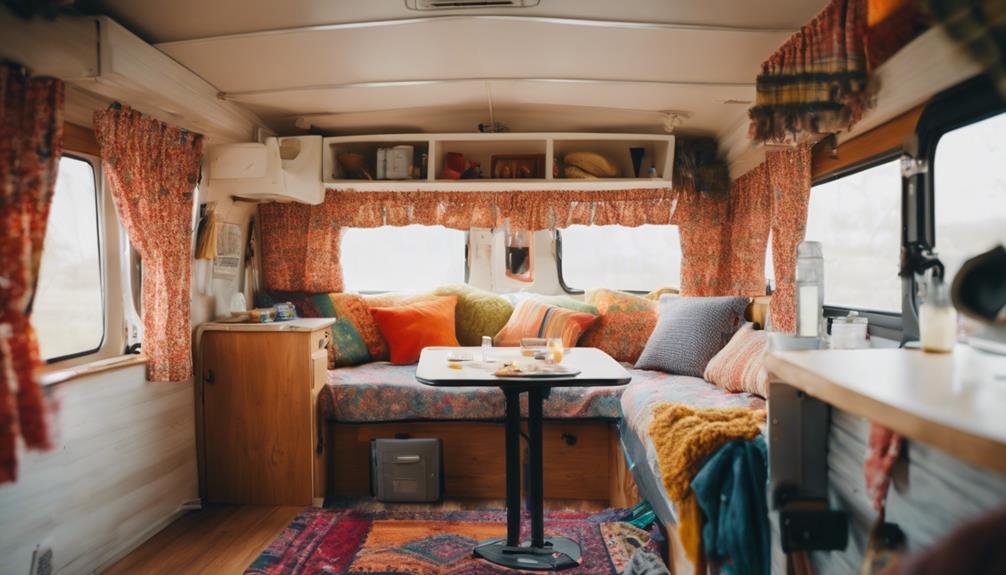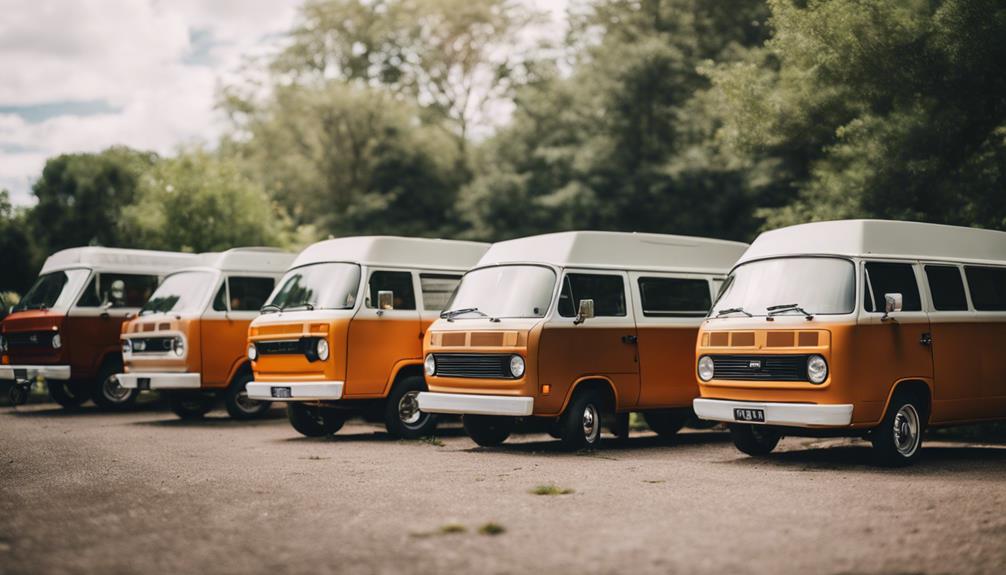When you're choosing the best vehicle for your camper conversion, consider options like the Mercedes Sprinter for its spacious interior and sturdiness, or the Ford Transit for its affordability and fuel efficiency. The Ram ProMaster is great if you want budget-friendly and urban maneuverability. For a compact option, the Nissan NV200 is perfect for solo travelers. If you prefer something traditional, the Chevrolet Express offers reliability. Each vehicle has its pros and cons, so weigh your needs carefully. Stick around to uncover more insights and tips to make your camper conversion project a success!
Introduction
When you're considering a camper conversion, choosing the right vehicle is essential for creating a comfortable and functional living space on wheels. The top contenders in the market include the Mercedes Sprinter, Ford Transit, and Ram ProMaster, each with unique features to fit different needs.
The Mercedes Sprinter is known for its spacious interior and superior build quality, making it a prime choice for extensive camper van conversions and long-term travel.
If you prioritize fuel efficiency and versatility, the Ford Transit might be your best bet. Its various size options and ease of maintenance appeal to many DIY converters looking for adaptability.
For those on a tighter budget, the Ram ProMaster stands out with its wide interior layout and front-wheel drive, which enhances maneuverability in urban settings.
When selecting your vehicle, consider factors like budget, interior space, and fuel efficiency. Each choice has its advantages, so assess your specific needs and preferences to guarantee a successful camper conversion project.
This initial step sets the foundation for a comfortable and enjoyable adventure on the road.
Background Information
When you think about camper conversions, it's crucial to understand their history and how they've evolved over time.
You'll notice an exciting shift with the emergence of electric camper vans, which are gaining popularity for their eco-friendly benefits.
This background sets the stage for exploring the various options available today.
Van Conversion History Overview
The history of van conversions traces back to the 1960s, when the Volkswagen Type 2 emerged as an icon of freedom and adventure, symbolizing the burgeoning counterculture movement. This period sparked the initial interest in the camper van market, as people sought mobility and new experiences on the open road.
By the late 1970s and 1980s, the market expanded with models like the Dodge Ram Van and Ford Econoline, designed for family travel and outdoor adventures.
As the 1990s rolled around, specialized conversion companies began to flourish, offering tailored amenities that appealed to those embracing van life. This trend continued into the early 2000s, driven by the rise of the digital nomad lifestyle, where individuals sought flexible living arrangements that allowed them to work and travel simultaneously.
Today, DIY van conversion communities have gained significant traction, fueled by social media and online forums that share resources and inspiration. These platforms have transformed the landscape of van conversion history, making it easier than ever to create personalized mobile living spaces that cater to diverse lifestyles and adventures.
Emergence of Electric Camper Vans
As consumers increasingly prioritize eco-friendly travel options, electric camper vans are emerging as a popular choice for outdoor enthusiasts and adventurers alike.
With the demand for sustainable travel on the rise, sales of electric camper vans are projected to reach 1.8 million units globally by 2030. Major players like Volkswagen and Mercedes-Benz are leading the way, introducing models such as the VW ID. Buzz and the eSprinter, which blend traditional camper van features with electric powertrains.
These electric camper vans come equipped with advanced technology, including regenerative braking and smart energy management systems, enhancing energy efficiency.
Most models offer a driving range of 200-300 miles on a full charge, making them perfect for weekend getaways and short trips. Plus, incentives like government rebates and tax credits are making these eco-friendly alternatives more financially accessible than ever.
Recent Electric Van Innovations

Recent electric van innovations are transforming your travel experience with advanced technology and improved battery efficiency.
With models like the Ford E-Transit and Mercedes-Benz eSprinter, you can enjoy longer ranges and flexible options tailored to your needs.
Plus, as charging infrastructure expands, hitting the road in an electric camper van has never been more practical.
Electric Van Technology Advancements
Innovations in electric van technology are revolutionizing the camper conversion market, making it easier than ever to commence eco-friendly adventures.
Electric versions of popular models like the Ford E-Transit and Mercedes eSprinter offer you the chance to enjoy zero-emission driving while minimizing operational costs.
With the introduction of the Rivian R1T and Canoo Lifestyle Vehicle, you can access electric options designed specifically for adventure, featuring customizable interiors perfect for your camper needs.
These electric vans are equipped with advanced battery technology, allowing for impressive ranges of over 200 miles on a single charge.
Plus, fast-charging capabilities mean you can replenish your battery in as little as 30 minutes, giving you more time to explore.
The integration of energy management systems and regenerative braking further optimizes your energy consumption, enhancing efficiency during your travels.
Battery Range and Efficiency
The latest advancements in battery technology are making electric vans more efficient than ever, considerably boosting their range and usability for camper conversions. For instance, the Ford E-Transit offers an EPA-estimated battery range of up to 126 miles on a single charge, while the upcoming Ram ProMaster is expected to reach around 250 miles, catering perfectly to your adventurous spirit.
These electric vans utilize advanced lithium-ion batteries that enhance energy efficiency and reduce charging times, with many models achieving 80% charge in under an hour. Plus, features like regenerative braking not only extend battery life by recovering energy during deceleration but also improve overall efficiency, making your journeys smoother and more sustainable.
Additionally, manufacturers are increasingly integrating solar panel options into electric vans. This allows you to generate renewable energy while parked, enhancing your off-grid capabilities and ensuring you can stay powered up during remote adventures.
With options like the Mercedes EQV also hitting the market, you'll find that the landscape of camper conversions is evolving, offering you the perfect blend of sustainability and functionality. Embrace the future with electric vans that meet your needs and aspirations!
Pros and Cons Overview
When considering camper conversion vehicles, you'll want to weigh the advantages and disadvantages of each model.
Understanding expert insights and comparing their performances can help you make an informed choice.
Let's break down the key points to help you decide what suits your needs best.
Advantages and Disadvantages Summary
Considering camper conversion vehicles, each option presents a unique blend of advantages and disadvantages that can greatly impact your travel experience.
The Mercedes Sprinter offers exceptional build quality and generous interior space, but its high upfront cost and maintenance can be a drawback.
On the flip side, the Ford Transit is known for affordability and solid fuel efficiency, though it sacrifices some interior height and customization options.
The Ram ProMaster shines with excellent maneuverability and a spacious layout, ideal for custom builds. However, its fuel efficiency isn't as impressive, and it tends to have a lower resale value.
If you're looking for a compact, budget-friendly option, the Nissan NV200 is easy to maneuver, but you'll find limited living space and amenities for longer trips.
Lastly, the Chevrolet Express is a reliable traditional choice, boasting availability and ruggedness. Still, it generally lacks the fuel efficiency and modern features found in newer models.
Weighing these advantages and disadvantages will help you choose the right camper conversion vehicle that suits your travel needs.
Industry Expert Insights
Industry experts highlight several key pros and cons of popular camper conversion vehicles, helping you navigate the choices available.
The Mercedes Sprinter is often praised for its spacious interior and reliability, but it comes with a higher upfront cost and potentially steep maintenance fees.
On the other hand, the Ford Transit stands out as a popular choice due to its multiple size options and good fuel efficiency, although it may offer less interior height than the Sprinter.
If you're looking for budget-friendly alternatives, the Ram ProMaster is known for its lower pricing and excellent maneuverability, yet it generally lags in fuel efficiency and resale value compared to its competitors.
For city dwellers, the Nissan NV200 provides a compact and budget-friendly option, but you may find the limited interior space lacking for extensive living amenities.
Finally, the Chevrolet Express is a traditional choice with good availability, though it might lack some modern features and customization options you might desire.
Ultimately, understanding these pros and cons will help you choose the best vans for camper conversions tailored to your needs and budget.
Model Performance Comparison
Evaluating camper conversion vehicles reveals distinct advantages and disadvantages that can considerably impact your decision.
The Mercedes Sprinter stands out with superior interior space and high resale value, making it an excellent choice for extensive camper conversions. However, its higher upfront cost and potentially steep maintenance costs (ranging from $3,000 to $5,000 over five years) can be a deterrent.
On the other hand, the Ford Transit strikes a balance between affordability and good fuel consumption, averaging 15 mpg city and 19 mpg highway. While it offers a new model specifically for conversions, its limited interior height may restrict your design options.
The Ram Promaster is budget-friendly, offering excellent maneuverability and versatile layouts. However, you'll find its fuel efficiency lower (14-16 mpg city and 19-21 mpg highway) and resale value not as robust as the Sprinter's.
Ultimately, your choice will hinge on what you prioritize: if you want spaciousness and high resale, the Sprinter is ideal; for affordability and efficiency, consider the Transit or Promaster. Assess these factors carefully to find the best fit for your camper conversion project.
Essential Tools for Conversion

When you're gearing up for a camper van conversion, having the right tools is key to making the process smooth and efficient.
You'll need essentials like a power drill and measuring tape to get everything just right.
Let's explore the must-have tools and techniques that'll set you up for success in your conversion journey.
Conversion Process Overview
To successfully tackle a camper van conversion, you'll need a set of essential tools that streamline the process and guarantee quality results.
First and foremost, a measuring tape is vital for accurate layout planning. It helps you determine dimensions and assures everything fits perfectly in your van. You'll also need safety equipment like gloves, goggles, and a dust mask to protect yourself during the conversion process.
When it comes to cutting wood, a circular saw and a jigsaw are indispensable. They allow you to make both straight and intricate cuts with ease. A drill is essential for assembling fixtures and installing furniture, making your build sturdier. Additionally, a multi-tool can simplify various tasks, from tightening screws to cutting materials, enhancing efficiency.
Portable power tools, such as a sander and a router, are key to achieving high conversion quality. They help you create smooth finishes and precise edges in your cabinetry and structural components.
With these essential tools at your disposal, you'll be well-equipped to transform your camper van into a cozy and functional space.
Essential Tools and Techniques
Having the right tools makes all the difference in your camper van conversion, so let's explore the key equipment you'll need for a successful build.
First, a power drill is essential for installing cabinetry and fixtures; it saves you time and effort.
Next, a saw—whether a jigsaw or circular saw—is critical for cutting wood and other materials to your desired dimensions.
For any electrical work, a multimeter is a must-have. It allows you to test voltage and confirm safe connections during installation.
Accurate measurements are important, so invest in reliable measuring tools like a tape measure and square to guarantee everything fits perfectly within your space.
Don't forget a level to guarantee surfaces like countertops and shelving are even. This helps prevent water drainage issues and enhances usability.
Finally, prioritize your safety with appropriate safety gear such as gloves, goggles, and a dust mask. Protecting yourself during the camper van conversion process is just as important as the installation itself.
With these tools and techniques in hand, you're well on your way to creating the perfect mobile retreat.
What Makes Ambulances a Unique and Functional Choice for Camper Conversion Projects?
When it comes to camper conversion projects, choosing the best ambulance camper conversion can be a unique and functional option. Ambulances offer a sturdy build, ample space, and existing infrastructure such as electrical systems and storage compartments, making them an ideal choice for creating a customized and practical camper.
Conclusion
In summary, choosing the right camper conversion vehicle hinges on your budget, preferences, and intended use, with options like the Mercedes Sprinter, Ford Transit, and Ram ProMaster each offering unique advantages.
The Mercedes Sprinter stands out for its quality builds, spacious interior, and high resale value, making it a top choice for the best van conversions.
If you're looking for versatility, the Ford Transit provides multiple sizes and configurations, along with excellent fuel economy, especially in the new 2023 model tailored for van conversions.
On the other hand, the Ram ProMaster is budget-friendly and features a spacious interior, making it ideal for urban maneuverability and simpler conversion processes.
When considering conversion costs, be aware that basic projects can start around $7,500, while luxurious builds may exceed $100,000.
If you're eyeing used vans, it's essential to inspect their mileage and mechanical condition, as those with under 50,000 miles generally require fewer repairs.
Ultimately, each option has its merits, and with careful consideration, you can find the ideal choice for your camper conversion project.
Frequently Asked Questions
What Is the Best Vehicle for Camper Conversion?
When choosing the best vehicle for camper conversion, consider your budget, space needs, and intended use. Options like the Mercedes Sprinter and Ford Transit offer great features, but weigh affordability against your specific requirements.
What Is the Best Budget Van to Convert to Camper?
If you're looking for a budget van to convert into a camper, consider the Ford Transit Connect or Ram Promaster City. Both offer great fuel efficiency and ample space without breaking the bank on purchase price.
How to Pick a Van for Conversion?
To pick a van for conversion, focus on size, reliability, and budget. Evaluate your intended use, necessary amenities, and maintenance history. Don't forget to take into account fuel efficiency for long-term travel costs.
What Is the Best Van for Full Time Living?
When considering the best van for full-time living, you should prioritize spaciousness, reliability, and fuel efficiency. The Mercedes Sprinter, Ford Transit, and Ram ProMaster all offer excellent options tailored to your lifestyle needs.
Conclusion
To sum up, choosing the right camper conversion vehicle can make all the difference in your adventure.
With various options available, consider your needs and preferences carefully.
Embrace recent innovations in electric vans for an eco-friendly twist, and remember to weigh the pros and cons of each vehicle.
By equipping yourself with essential tools and knowledge, you're well on your way to creating the perfect home on wheels.
Start your journey and enjoy the freedom of the open road!











